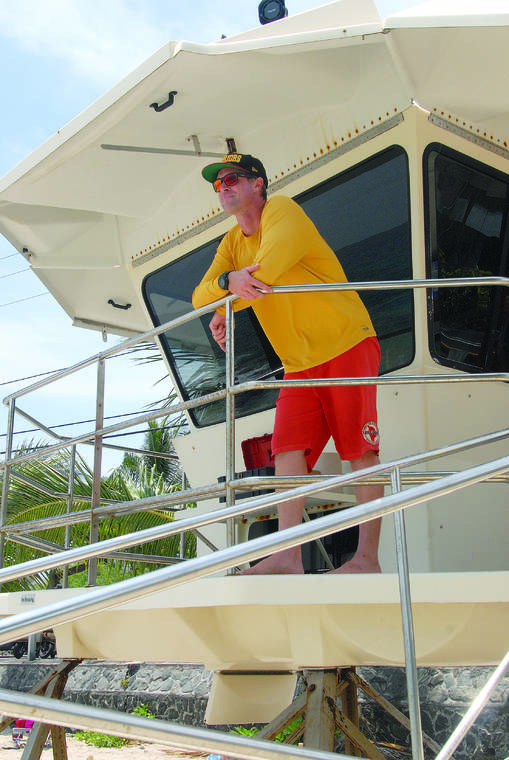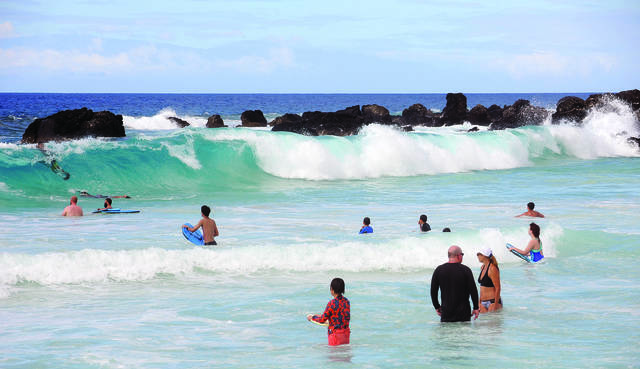‘This funding will save lives’: Money budgeted for lifeguards at Kua Bay
KAILUA-KONA — Lifeguards have been funded for Kua Bay.
Six years after legislators began the effort to bring full-time life-saving personnel to the North Kona state beach known for its beauty and danger, funding was included in the state budget for lifeguards at Kua Bay.
The move happened Thursday afternoon during a Finance conference committee hearing when $480,000 was added to the state budget, House Bill 116, and passed, according to House Rep. Nicole Lowen (D-North Kona) and Sen. Dru Kanuha (D-Kona, Ka‘u). The bill next needs a final reading in the Legislature before heading to Gov. David Ige for his signature.
“I’m thrilled that we finally funded these needed lifeguard positions, and relieved to know that the necessary steps are being taken to ensure safety at Kua Bay,” said Lowen. “This funding will save lives.”
Hawaii County Mayor Harry Kim, who submitted testimony for every hearing over lifeguards at Kua Bay, was happy with the news as well.
“Those who knew the need and fought for the need all these years, I am so happy that an appropriation in the budget was made,” he said Thursday afternoon, noting the island’s support outside West Hawaii for lifeguards at Kua Bay. “This is much needed and will be much appreciated when it comes reality.”
The appropriation was added to the budget just hours after House Bill 558, which had made it through both chambers of the Legislature, died following three days of consideration before a Water, Land and Hawaiian Affairs conference committee.
That bill, co-introduced by Lowen and Rep. David Tarnas (D-North Kona, South and North Kohala) among others, made it the farthest of any bill introduced to secure lifeguards at Kua Bay has since 2013.
It was one of three bills introduced this session with only HB 558 making it beyond the first reading after crossing over. Each was important in securing the allocation Thursday.
“All of the bills were necessary,” said Kanuha, who introduced his own measure in the state Senate. “But we just ended working with each other and stuck it in the budget under DLNR.”
The popular, yet perilous North Kona beach once required a lengthy hike in or a four-wheel-drive vehicle to access until 2005 when a nearby developer completed paved access to and amenities at the site as part of a community benefit assessment. The state has since added improvements, most recently picnicking areas and concrete stairs to the south end of the beach.
The beach was identified by the state as the next site to receive lifeguards due to it having “the most reported spinal cord injuries,” according to testimony by DLNR Chairwoman Suzanne Case. Per the Hawaii Department of Health, 32 people required treatment at Kua Bay from 2013 to 2018 with 30 needing transport to a hospital. All but three of those sent to the hospital suffered traumatic injuries.
DLNR Division of State Parks Administrator Curt Cottrell said the additional funding for lifeguards at Kua Bay will bring the amount spent by the state for county lifeguards at five state parks to $3.7 million.
“DLNR is grateful that the legislature recognizes the need to improve the public safety at Kua Bay, which has become a heavily visited State Beach park due to the robust tourism industry,” he said. “Absent this additional new funding, due to insufficient operating funds and revenue shortfalls associated with the Napali closure on Kauai and the recent closure of the Nuuanu Pali Lookout, providing the critically needed water safety service through the County lifeguards is a fiscal impossibility. The Division of State Parks looks forward to collaborating with Hawaii County to add Kua Bay to their water safety program.”
Gerald Kosaki, a retired Hawaii Fire Department battalion chief who oversaw rescue operations and now co-chairs the Hawaii Drowning and Aquatic Injury Prevention Advisory Committee, is “stoked” for lifeguards at the beach park.
“The best prevention of injuries and drowning is to have people swim at a beach that has a lifeguard. Signs and websites can only do so much, but if someone is actually there it’s much safer for the public,” said Kosaki, who retired Dec. 1. “Now with all the increase in people going down to Kua Bay and that area, I think it will be a big, big help and improvement to help reduce injuries and hopefully any fatalities from drowning.”
The Kua Bay lifeguard funding comes the same week the Department of Health and Hawaii Drowning and Aquatic Injury Prevention Advisory Committee unveiled a website and campaign to reduce ocean injuries and drownings.
The new website, www.hioceansafety.com, encourages residents and visitors to swim at beaches with lifeguards to prevent drownings or serious injury in the ocean.
“Choosing beaches with lifeguards who can respond quickly to those in the ocean is a matter of life and death. The sooner a person in distress in the ocean can get help, the better their chance of survival,” said Ralph Goto, another advisory committee co-chair.
The website currently makes no mention of Kua Bay, just sites where lifeguards are stationed. On the west side, that includes Kahaluu Beach Park, Laaloa Beach Park, Hapuna Beach State Recreation Area and Spencer Beach Park (on the weekends, holidays and school breaks). Come next year, Kua Bay will be on that list.




